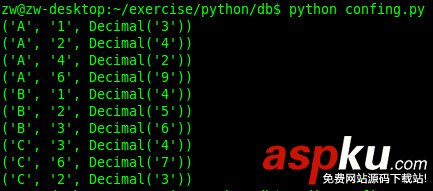这个语法是用来代替传统的try...finally语法的。
复制代码代码如下:
with EXPRESSION [ as VARIABLE] WITH-BLOCK
基本思想是with所求值的对象必须有一个__enter__()方法,一个__exit__()方法。
紧跟with后面的语句被求值后,返回对象的__enter__()方法被调用,这个方法的返回值将被赋值给as后面的变量。当with后面的代码块全部被执行完之后,将调用前面返回对象的__exit__()方法。
复制代码代码如下:
file = open("/tmp/foo.txt")
try:
data = file.read()
finally:
file.close()
使用with...as...的方式替换,修改后的代码是:
复制代码代码如下:
with open("/tmp/foo.txt") as file:
data = file.read()
#!/usr/bin/env python
# with_example01.py
class Sample:
def __enter__(self):
print "In __enter__()"
return "Foo"
def __exit__(self, type, value, trace):
print "In __exit__()"
def get_sample():
return Sample()
with get_sample() as sample:
print "sample:", sample
执行结果为
复制代码代码如下:
In __enter__()
sample: Foo
In __exit__()
1. __enter__()方法被执行
2. __enter__()方法返回的值 - 这个例子中是"Foo",赋值给变量'sample'
3. 执行代码块,打印变量"sample"的值为 "Foo"
4. __exit__()方法被调用with真正强大之处是它可以处理异常。可能你已经注意到Sample类的__exit__方法有三个参数- val, type 和 trace。这些参数在异常处理中相当有用。我们来改一下代码,看看具体如何工作的。



















